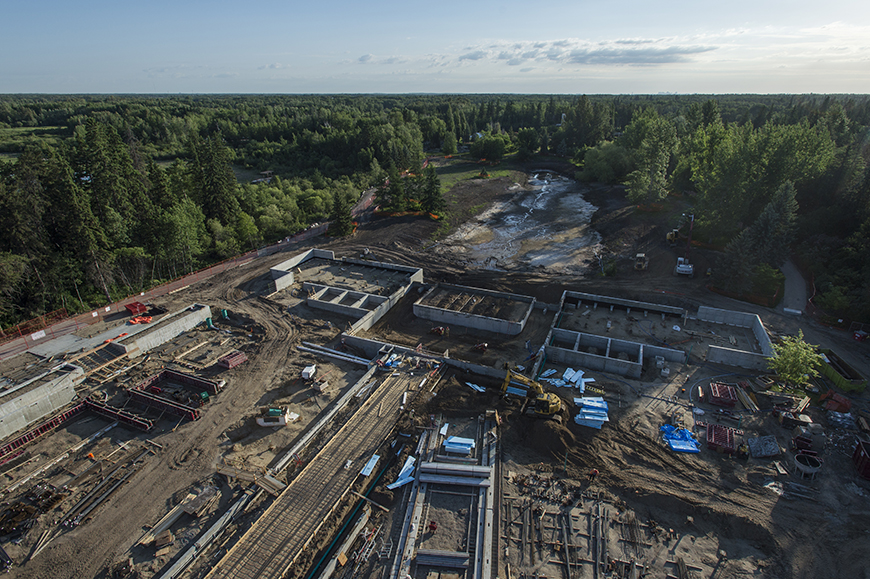
With construction of the huge Aga Khan Garden approaching the halfway mark, the site looks like one might imagine the Great Pyramids did as they were assembled.
Workers toiling at the sun drenched, 4.8-hectare slice of the existing University of Alberta Botanic Garden near Devon appear as mere specks against thick slabs of concrete that form wall stubs, terraces and ramps. Sharp angles and vast planes abound. Yet their atypical layout suggests something both exotic and magnificent is rising.
This Islamic-inspired garden, which will be North America's largest and one of only two on the entire continent, is expected to more than double annual attendance at the beloved botanic garden-to 160,000 people annually, from the current 75,000.
The sheer scope of the Aga Khan Garden, funded by a $25 million gift from His Highness the Aga Khan, the spiritual leader of the world's Ismaili Muslim community, is both challenging and exhilarating for the workers erecting it, said Lee Foote, director of the botanic garden.
"They're building something meant to last multiple centuries, not just a lifetime," he said. "I'm looking at a quality of construction that's far above anything I've ever seen." As an example, he said, the foundations go down 27 metres compared to a few metres for new homes, and the surface stonework is 10 centimetres thick.
There's pride at stake too, said Foote, as concrete workers and stone masons cut every angle of the geometrically inspired project precisely, while adhering to a schedule that has established an opening of the Aga Khan Garden in late spring 2018.
Ground was broken last fall at the site and visitors passing steel fencing on their way to the existing regions of the University of Alberta Botanic Garden get a clear view of the emerging garden's impressive features.
Its main section will feature wide stepped terraces, an upper section of covered pillars, and a waterfall spilling into a large tranquil pond that's surrounded by orchards. Nestled in the woodland that is the garden's entry is a reflecting pool and amphitheatre. Those elements are so close to their final shape that it's easy to envision how soothing that secluded zone will be.
Down a service road sit samples of the giant granite pavers that will cover the ample terraces and pathways. In multiple shades of grey that will subtly change hue depending on the light and the weather, they are subtly etched with lines that will create mosaic-like patterns when the stones are placed together.
Elsewhere, a newly built greenhouse is stuffed to overflowing with some of the more than 25,000 perennials, shrubs and trees being grown to populate the Aga Khan Garden and adjoining fruit orchard.
Meanwhile, 14 other projects are also underway throughout the botanic garden proper. They all tie into the transformation of a heritage Alberta attraction that until this past spring had been known for several decades as the Devonian Botanic Garden.
"We're trying to plan out for 25 years," said Aaron Corser, UAlberta's project manager for the Aga Khan Garden. "So that's a lot of pieces to move around."
Those pieces include the creation of new sewage and water distribution systems, installing fibre optic cable to the botanic garden's research trailers and administration building, building a game fence to keep moose at bay, tripling the number of parking spaces, improving a service road, and rebuilding several plant plots.
Since the University of Alberta Botanic Garden is the terminus of the River Valley Alliance's Capital Project-a continuous park system connecting Fort Saskatchewan to Devon-the botanic garden's portion of the trail that links it to the North Saskatchewan River is ready to open, to coincide with Parkland County's own section due to have a ribbon cutting this summer. Foote says the linkage will make it natural for hikers, bikers and rollerbladers to include the botanic garden in their outings.
Other planned elements of the garden's renewal fall into the "coming soon" category.
Configuration of the main entrance is still being finalized, and a pavilion attached to the Aga Khan Garden has been designed but is not yet fully funded. Besides offering shelter from the weather for programming events, it will be climate-controlled and outfitted with video security and teleconferencing links so it can host everything from weddings to small conferences, travelling displays to art exhibits.
"Its cost is in the $5 million range," said Foote, who noted that fundraising has begun and offering naming rights within the structure is a viable idea. "There are recognition opportunities for donors to participate in the next logical step that's being planned here."
Foote is also working on a visitor perk that he hopes will be ready within the first year of the Aga Khan Garden's life. With Hussein Keshani, an art and history expert at the University of British Columbia-Okanagan and Michael Frishkopf, an ethnomusicologist at the University of Alberta, he is working on a digital app to enrich visits to the garden.
Via an iPad or other mobile device, geo-locators will sense where in the garden visitors are standing and provide a rich soundscape that presents historical, artistic and botanical information.
Clearly, this is not the botanic garden of Alberta's past.
"In my mind, I refer to it as a new garden," said Foote. "There's a new name, new ways of doing things, this new feature (the Aga Khan Garden). We want to court individuals who have been here before and think they've seen it. It's actually a dynamic new place that needs to be seen again."